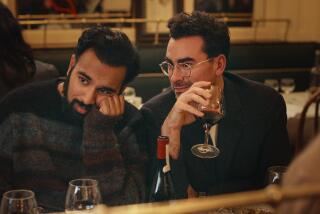Everything goes bump in this ‘Night’
- Share via
Director Shawn Levy just returned from promoting his latest film, “Night at the Museum,” in London; Frankfurt, Germany; and Rome. The questions he received from the foreign journalists were a little left of field, he reports. “Is your movie an allegory of the value of knowing history?” “Is it a commentary on United States politics and the myopic stance of the current administration?”
“It’s always interesting going over there,” he says.
“Night at the Museum,” which opens Friday, is actually a family fantasy comedy. Ben Stiller plays a divorced dreamer with a young son who takes a job as the night security guard at the American Museum of Natural History in New York. On his first night, he learns it’s no menial position, because as soon as the sun goes down, all the creatures on display -- a wax Teddy Roosevelt (Robin Williams) sitting atop a stuffed horse, a T-Rex, ancient warriors, prehistoric animals and some of history’s legendary heroes and villains -- magically come to life.
Dick Van Dyke, Mickey Rooney and Bill Cobbs are also in the cast as elderly security guards forced to retire.
“The hidden life of things is such a basic question for all of us, and the movie definitely takes that question mark and opens it up,” says Levy, whose previous credits include “Cheaper by the Dozen” and “Just Married.”
“Certainly all of us who work in films are constantly on the lookout for the next big idea,” he continues. “To me, ‘big idea’ implies not only simply largesse, but tapping into a collective fantasy or a collective unconscious of ‘what if.’ There is such a big, relatable ‘what if’ at the core of the movie.”
Levy populated the film with comic actors because he wanted not only to make “Night at the Museum” an adventure but also “to do it with a level of comedy that adventure films don’t normally have.”
“There is no question that juggling this many inspired comedic minds was far more time consuming than [working with] kids, animals or visual effects,” he says. “But it’s a great problem to have.”
Stiller, says Levy, is a perfectionist of the highest order. “But he will do a take or two of a scene as scripted and then he’ll want to go explore. Oftentimes, it will be a line that will lead to an idea that will lead to an entire new premise of a scene.”
Case in point: the sequence in which Stiller psychoanalyzes Attila the Hun. “That was unscripted, totally improvised,” Levy says.
Even special effects were improvised.
“The rules of visual-effects directing is that you are supposed to have a plan and follow it quite rigidly,” Levy says. “But the rules of comedy superseded the rules of visual effects on this shoot. Ben and I would come up with an idea to add a woolly mammoth to a scene, or a moose. I would look over at my visual-effects team and I would literally watch the blood draining from their faces. But to their credit, they got with the program.”
*
-- Susan King
More to Read
Only good movies
Get the Indie Focus newsletter, Mark Olsen's weekly guide to the world of cinema.
You may occasionally receive promotional content from the Los Angeles Times.










